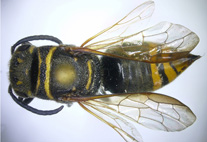Abstract
Triatoma rubrofasciata (De Geer) is the first species of triatomine described, and little is known on its vector biology. Studies are restricted to starvation resistance, interspecific morphometric variability, morphometry of testis follicles, coloration of the testicular peritoneal sheath, ultrastructure of the male accessory glands, phylogeny and cytogenetics. Thus, this study aims to address the karyosystematics of T. rubrofasciata and the possible events related to karyotype evolution of this species. Four adult males were analyzed cytogenetically. The analysis of meiotic metaphases of T. rubrofasciata allowed to confirm the karyotype of species, out more, 2n = 25 (22A + X1X2Y). This number is very important for taxonomic and evolutionary inferences on the species, because of the 88 triatomine species with described karyotype, only T. rubrofasciata exhibits 25 chromosomes. Based on the hypothesis of the karyotype 2n = 22 (20A + XY) as ancestral for triatomines, we propose three evolutionary hypotheses for the emergence of the karyotype of T rubrofasciata, all supported by agmatoploidy events (fission). Basically the hypotheses are 1) fission for a pair of autosomes, resulting in 22 autosomes and later fission of sex chromosome X; 2) fission of pair of autosomes and the sex chromosome X concomitantly; 3) fission of sex chromosome X and subsequently fission of pair of autosomes. Thus, this study highlights for the first time the importance of the number of chromosomes of T. rubrofasciata as characteristic diagnosis in Triatominae subfamily and describes three evolutionary hypotheses that possibly led the emergence of karyotype of this insect of global importance.

